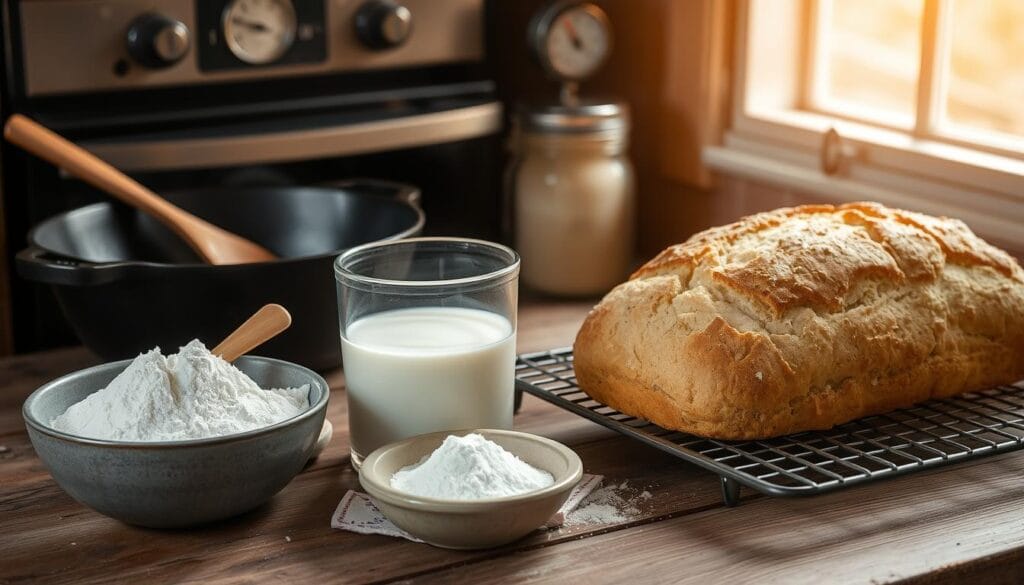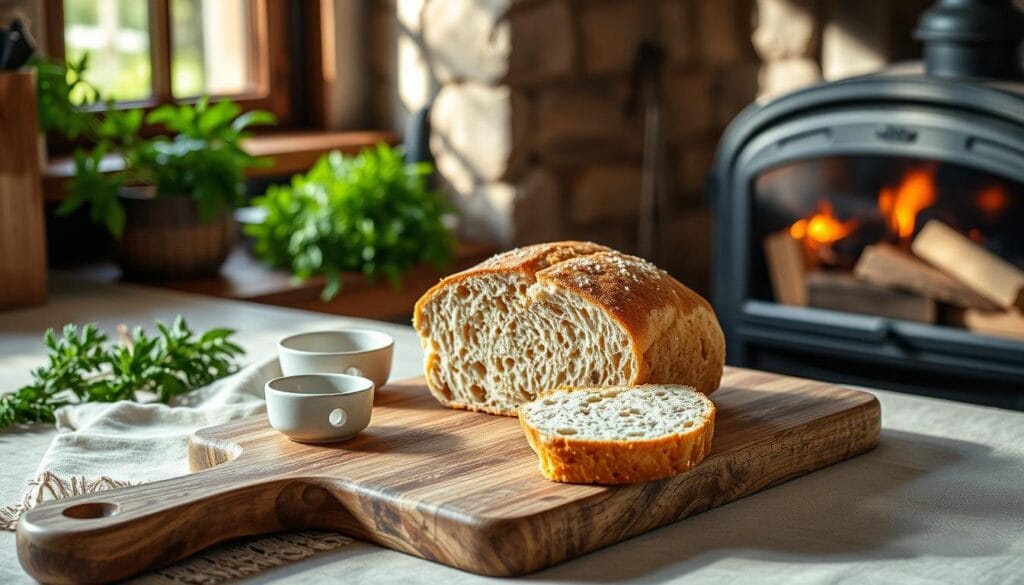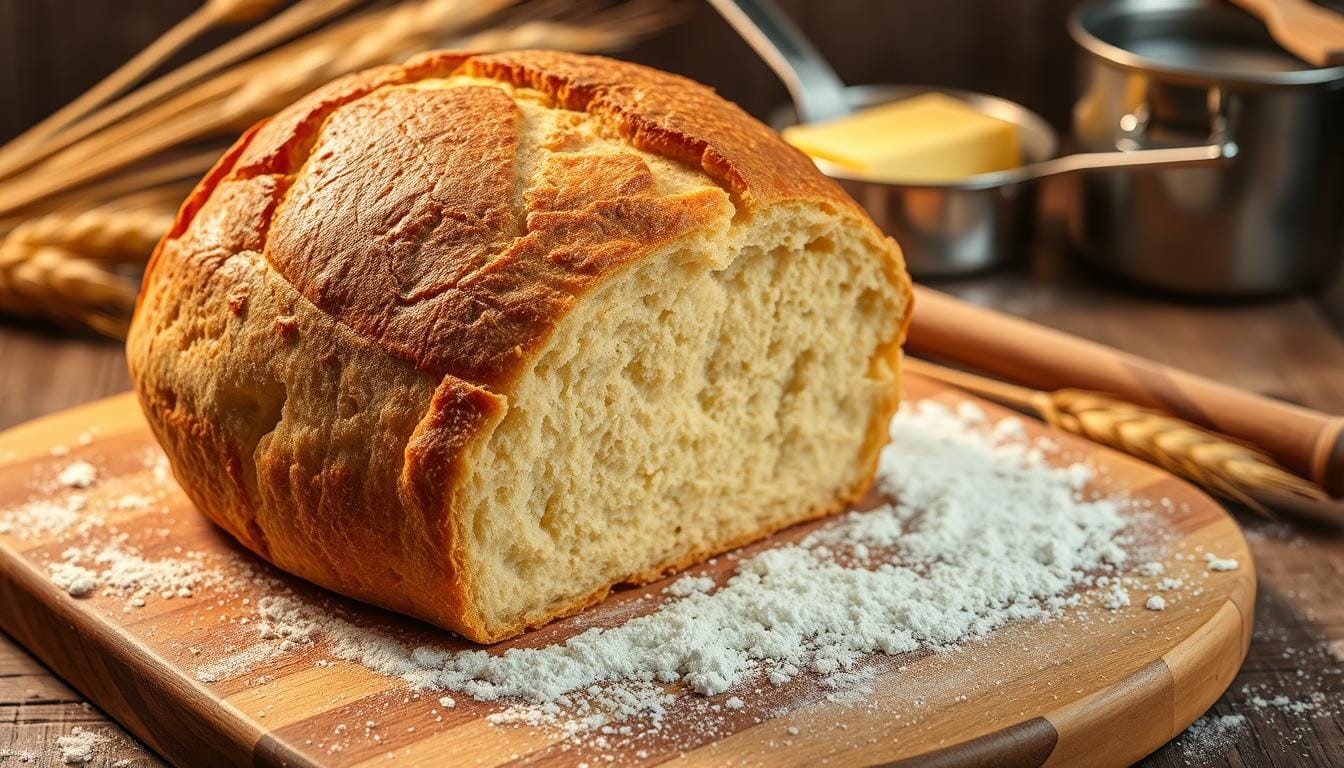Irish soda bread is a quick bread loved for centuries. It skips yeast, using baking soda and buttermilk for a rustic taste. This makes it special and easy to make.
This bread is a simple yet smart way to bake. With just a few ingredients, you can make a hearty loaf. It connects you to Ireland’s rich baking traditions. It’s perfect for both experienced and new bakers, offering authentic flavor.
Table of Contents
Understanding Irish Soda Bread: A Heritage Recipe
Irish soda bread is more than a simple recipe. It’s a story of survival and culture. It was born in hard times and fed many Irish families.
Origins and Cultural Significance
The history of Irish soda bread started in the mid-1800s, during the Great Potato Famine. Families made this bread quickly and cheaply. Baking soda, introduced in 1840, changed bread-making forever.
“Necessity is the mother of invention” – This adage perfectly captures the spirit of Irish soda bread.
Why It’s Called Soda Bread
The name “soda bread” comes from baking soda. This ingredient makes the bread rise fast, without yeast. The mix of baking soda and buttermilk gives it a special taste and texture.
Traditional vs Modern Variations
Traditional Irish soda bread is simple, with just four ingredients:
- Irish wholemeal flour
- Baking soda
- Salt
- Buttermilk
| Traditional Recipe | Modern Adaptations |
|---|---|
| No added sugar | Often includes sugar |
| No eggs | May include eggs |
| Plain flour | Variety of flour types |
Today, bakers add raisins, currants, and herbs to the classic recipe. Yet, Irish soda bread stays true to its heritage.
Essential Ingredients for Authentic Irish Soda Bread
Making the perfect Irish soda bread is all about the right ingredients. Just a few simple things come together to make a delicious loaf.
The basic ingredients for Irish soda bread are:
- All-purpose flour
- Buttermilk
- Baking soda
- Salt
Baking soda is key in this bread. It makes the bread rise and gives it a special texture. This happens when buttermilk meets baking soda.
“The simplicity of Irish soda bread is what makes it truly remarkable.” – Traditional Irish Baker
You can add extras to make your soda bread even better:
- Butter (1 stick per 4 cups of flour)
- Currants or raisins (up to ½ cup)
- Caraway seeds
- Fresh herbs like thyme or chives
If you need gluten-free, you can use gluten-free flour instead. Just use the same amount as regular flour.
| Ingredient | Quantity | Purpose |
|---|---|---|
| All-purpose flour | 2 cups (280g) | Base structure |
| Buttermilk | 2 cups | Moisture and chemical reaction |
| Baking soda | 1½ teaspoons | Leavening agent |
| Salt | 1½ teaspoons | Flavor enhancement |
Pro tip: Always check the freshness of your baking soda by testing it with vinegar. If it fizzes immediately, it’s ready to use!
The Secret Role of Buttermilk in Irish Soda Bread
Buttermilk is a key player in Irish soda bread, adding more than just moisture. It’s a secret ingredient that makes the bread special.
Buttermilk and baking soda react in a way that changes the bread’s texture and taste. The acid in buttermilk activates the baking soda. This makes the bread light and tender, just like traditional quick bread.
Why Buttermilk is Crucial
Buttermilk is essential for soda bread:
- It tenderizes the bread by breaking down gluten strands
- It adds a rich, tangy flavor
- It helps with the perfect leavening action
- It makes the crust golden brown
Making a Buttermilk Substitute
Need a buttermilk substitute? You can make one with simple ingredients:
| Ingredient | Quantity | Preparation Method |
|---|---|---|
| Milk | 1 ½ cups | Use whole milk for best results |
| Vinegar | 1 tablespoon | Mix with milk and let sit for 5 minutes |
Temperature Considerations
Temperature is important when using buttermilk in bread. Cold buttermilk makes the bread flaky. Room temperature buttermilk mixes better.
“The secret to perfect Irish soda bread is understanding how buttermilk interacts with other ingredients.” – Traditional Irish Baker
Buttermilk’s acidity and temperature affect the bread’s texture and rise. Try different temperatures to see what works best for you.
Choosing the Right Equipment and Tools
When you’re ready to bake Irish soda bread, picking the right tools is key. The right equipment can greatly improve your bread’s quality. It’s all about choosing the best tools to make a delicious traditional bread.
Professional bakers suggest a few top choices for baking your soda bread:
- Cast iron skillet: Creates a crispy, golden-brown crust
- Baking sheet: Perfect for a more rustic, free-form loaf
- Ceramic baking pan: Provides even heat distribution
Here are the essential tools for making your rustic loaf:
- Large mixing bowl
- Measuring cups and spoons
- Pastry brush
- Sharp knife for scoring
- Kitchen scale for precision
“The right tools transform baking from a task to an art.” – Traditional Irish Baker
The type of baking equipment you use affects your bread’s texture and crust. A cast iron skillet gives a crisper crust. A baking sheet lets you make a traditional shape. Think about what you want your bread to look like when choosing your baking vessel.
Quality measuring tools are crucial for consistent baking. A kitchen food scale is more accurate than regular measuring cups. It helps you make the perfect rustic loaf every time.
Step-by-Step Mixing Technique
Making the perfect Irish soda bread needs care and a light touch. Success comes from knowing the special mixing steps that make this bread unique.
Proper Dough Consistency
Getting the dough right is key in baking traditional soda bread. You want it to look a bit shaggy and rough, unlike regular bread dough. Just mix enough to blend the ingredients.
- Use a light hand when mixing
- Stop stirring when ingredients are barely incorporated
- Aim for a wet, sticky texture
Handling and Kneading Tips
When working with soda bread dough, remember that less is more. Overworking can make your bread tough and dense. Gently fold the ingredients together with a spatula or your hands.
“The beauty of soda bread is in its rustic, imperfect nature.” – Traditional Irish Baker
| Mixing Technique | Recommended Action |
|---|---|
| Initial Mixing | Stir until just combined |
| Kneading | 2-3 gentle folds, max |
| Dough Texture | Slightly shaggy, not smooth |
Scoring the Dough
Scoring the dough makes a distinctive cross on your Irish soda bread. This mark isn’t just for looks; it helps the bread bake evenly. Use a sharp knife to cut an X about 1/2 inch deep across the top of the loaf before baking.
- Cut a deep cross in the center
- Ensure cuts are about 2 inches long
- Score just before baking
Baking Methods and Temperature Control

Getting the baking right is key to making perfect Irish soda bread. The right temperature and methods can turn a good bread into a great one.
Here are the important steps to follow:
- Preheat your oven to 425 degrees Fahrenheit
- Use a cast iron skillet or heavy baking sheet
- Ensure even heat distribution
Baking time should be between 35 to 45 minutes. Cast iron pans take longer because they hold heat well. Pro tip: Listen for a hollow sound when tapping the bottom of the bread – this indicates it’s fully baked.
“Baking is an art, and soda bread is your canvas.” – Traditional Irish Baker
Here are the temperature tips for your rustic loaf:
| Baking Stage | Temperature | Duration |
|---|---|---|
| Preheating | 425°F | 15-20 minutes |
| Initial Baking | 425°F | 20-25 minutes |
| Finishing | 375°F | 10-15 minutes |
Keep an eye on your bread as it bakes. A golden crust and an internal temperature of 190-200°F mean it’s done right.
The Perfect Crust and Texture Guide
Making the perfect Irish soda bread is all about the crust and crumb. With the right techniques, simple ingredients become a work of art.
To get a golden-brown crust, you need precision. Aim for a bread with a crispy outside and a soft inside.
Achieving the Perfect Golden Brown Crust
- Preheat your oven to 425°F for an initial high-heat blast
- Use a cast-iron skillet or heavy baking sheet for even heat distribution
- Brush the top with buttermilk for enhanced browning
- Reduce temperature to 375°F after the first 10 minutes of baking
Testing for Doneness
A perfectly baked Irish soda bread shows its readiness in several ways. Listen for the hollow sound when tapping the bottom. This means it’s fully cooked inside.
“A great soda bread speaks to all your senses – from its golden crust to its tender crumb.” – Traditional Irish Baker
Here are the key signs of doneness:
- Internal temperature should reach 190-200°F
- Crust should be deep golden brown
- Bread should feel light for its size
- No raw dough visible when cutting
Pro tip: Let your bread cool for 15 minutes before slicing. This resting period helps the crumb set, making each slice perfect.
Adding Optional Ingredients: Raisins and Seeds
Irish cuisine adds a twist to traditional soda bread with optional ingredients. Raisins and seeds make the classic recipe more flavorful. They delight your taste buds.
Irish soda bread isn’t just about four ingredients. Many home bakers enjoy adding raisins and other mix-ins. This makes the bread more exciting.
Popular Optional Ingredients
- Golden raisins (about 3/4 cup)
- Caraway seeds (1 tablespoon)
- Dried currants
- Sugar (small amount for sweetness)
Adding raisins makes your Irish soda bread special. Try the Spotted Dog recipe. It adds golden raisins for a sweeter, more indulgent treat.
“A good Irish soda bread tells a story of tradition and innovation with every slice.” – Irish Baking Experts
For a savory twist, try Seedy Bread. It includes caraway seeds and a bit of sugar. This gives it a unique flavor.
Ingredient Proportions
| Ingredient | Quantity | Purpose |
|---|---|---|
| Golden Raisins | 3/4 cup | Sweetness and Texture |
| Caraway Seeds | 1 tablespoon | Aromatic Flavor |
| Sugar | 2-3 tablespoons | Enhanced Sweetness |
Adding raisins can change your bread’s texture and baking time. Mix them gently to ensure even distribution. This keeps the bread’s structure intact.
Storage and Serving Suggestions

Keeping your homemade irish soda bread fresh is key. After baking, make sure it stays delicious for as long as you can.
Optimal Storage Techniques
Keep your irish soda bread in an airtight container at room temperature for up to 3 days. For longer storage, freeze it for up to 1 month. Wrap the bread tightly in aluminum foil or plastic wrap to keep it moist and prevent freezer burn.
Reheating and Serving
- Warm bread at 350°F (177°C) for 7-8 minutes to restore its fresh-baked texture
- Slice bread approximately 1/4 inch thick for optimal serving
- Pair with butter, citrus marmalades, or enjoy during st. patrick’s day celebrations
Freezing and Thawing Tips
| Storage Method | Duration | Recommended Approach |
|---|---|---|
| Room Temperature | Up to 3 days | Airtight container |
| Freezer Storage | Up to 1 month | Wrap tightly in foil |
| Thawing | Room temperature | Let bread sit for 1-2 hours |
“A well-preserved irish soda bread is a treasure that keeps on giving!” – Traditional Irish Baker
Irish soda bread is perfect for st. patrick’s day or a casual breakfast. It’s best enjoyed fresh, so try to eat it within a few days for the best taste and texture.
Common Mistakes to Avoid
Baking quick bread, like Irish soda bread, needs precision and care. Knowing common mistakes helps make a perfect loaf every time. Let’s look at the most common errors home bakers face.
Overmixing the Dough
One big mistake in making soda bread is overmixing. Too much mixing develops gluten, making the bread tough and dense. The trick is to stir until ingredients are just combined. This gentle mixing keeps the bread light and soft.
- Mix ingredients quickly and minimally
- Stop stirring as soon as the dough comes together
- Avoid aggressive kneading
Temperature Challenges
Temperature is key in quick bread baking. Cold buttermilk is essential for the right chemical reaction with baking soda. Warm ingredients can harm the bread’s rising.
| Ingredient | Ideal Temperature | Impact on Bread |
|---|---|---|
| Buttermilk | Refrigerator cold | Optimal rising |
| Butter | Chilled | Better texture |
| Oven | 425°F | Perfect baking |
Measuring Mistakes
Getting measurements right is crucial in quick bread recipes. Use standard cups for dry ingredients and clear cups for wet ones. A good ratio is 4 cups flour to 1 3/4 cups buttermilk.
“Baking is a science – precision matters more than creativity.”
Avoiding these mistakes will help you make delicious Irish soda bread. It will honor traditional baking methods.
Irish Soda Bread Serving Traditions
Irish cuisine is full of wonders, and Irish soda bread is no exception. It’s a star during St. Patrick’s Day and beyond. This bread goes from a simple treat to a main attraction.
Here are the top ways to enjoy this traditional bread:
- Pair with hearty stews and soups
- Serve alongside butter or honey butter
- Top with artisan jams
- Create a cheese board companion
Let’s look at the bread’s nutritional benefits:
| Nutritional Detail | Per Serving |
|---|---|
| Calories | 172 kcal |
| Carbohydrates | 23g |
| Protein | 3g |
| Fat | 7g |
Pro tip: Enjoy fresh soda bread within 3-4 days at room temperature. Freeze slices for up to 2 months for longer storage.
“Irish soda bread isn’t just food; it’s a culinary tradition that connects generations.” – Irish Culinary Expert
Irish soda bread is perfect for St. Patrick’s Day or a cozy meal. It brings a taste of Irish culture and invites you to be creative and warm.
Conclusion
Your journey through this traditional recipe shows the beauty of Irish soda bread. It’s a simple yet remarkable culinary treasure. With just an hour of preparation and cooking, you can make a bread that connects you to Irish home bakers for generations.
The magic of Irish soda bread lies in its simple ingredients. You need 4 cups of flour, buttermilk, and a few key additions. These ingredients turn basic components into a delicious loaf.
The traditional recipe we’ve explored shows how Irish soda bread is more than just food. Each slice is a piece of culinary heritage, made with minimal ingredients but lots of flavor. You can add raisins or keep it classic, making the bread your own while staying true to its cultural roots.
Learning this Irish soda bread recipe lets you bring a taste of Ireland into your kitchen. The technique is easy, requiring no special skills but offering great satisfaction. You now know how to make a bread that’s both rustic and refined.
Great cooking is about passion, practice, and connecting with culinary traditions. Your Irish soda bread journey is just starting. Each loaf will bring you closer to the heart of this beloved recipe.


1 thought on “The Best Traditional Irish Soda Bread”
Comments are closed.